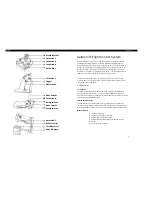
Input Points (X Data Type)
The discrete input points are noted by an X
data type. There are up to 512 discrete input
points available with the DL205 CPUs. In this
example, the output point Y0 will be turned on
when input X0 energizes.
Output Points (Y Data Type)
The discrete output points are noted by a Y data
type. There are up to 512 discrete output points
available with the DL205 CPUs. In this
example, output point Y1 will turn on when
input X1 energizes.
Control Relays (C Data Type)
Control relays are discrete bits normally used to
control the user program. The control relays do
not represent a real world device, that is, they
cannot be physically tied to switches, output
coils, etc. They are internal to the CPU. Control
relays can be programmed as discrete inputs or
discrete outputs. These locations are used in
programming the discrete memory locations (C)
or the corresponding word location which has
16 consecutive discrete locations. In this
example, memory location C5 will energize
when input X10 turns on. The second rung
shows a simple example of how to use a control
relay as an input.
Timers and Timer Status Bits (T Data type)
The amount of timers available depends on the
model of CPU you are using. The tables at the
end of this section provide the number of timers
for the DL230, DL240, D2-250-1 and DL260.
Regardless of the number of timers, you have
access to timer status bits that reflect the
relationship between the current value and the
preset value of a specified timer. The timer status
bit will be on when the current value is equal to
or greater than the preset value of a
corresponding timer.
When input X0 turns on, timer T1 will start.
When the timer reaches the preset of 3 seconds
(K of 30) timer status contact T1 turns on.
When T1 turns on, output Y12 turns on.
DL205 User Manual, 4th Edition, Rev. B
3–38
Chapter 3: CPU Specifications and Operations
1
2
3
4
5
6
7
8
9
10
11
12
13
14
A
B
C
D
Y0
OUT
X
0
Y1
OUT
X
1
Y12
OUT
T
1
T
MR
T
1
K30
X
0
C5
OUT
X10
Y
10
OUT
C5
Y
2
0
OUT
















































